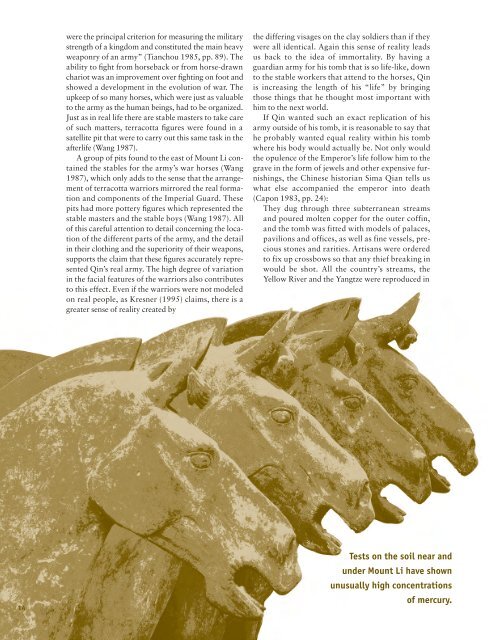Emperor Qin in the Afterlife
You also want an ePaper? Increase the reach of your titles
YUMPU automatically turns print PDFs into web optimized ePapers that Google loves.
were <strong>the</strong> pr<strong>in</strong>cipal criterion for measur<strong>in</strong>g <strong>the</strong> military<br />
strength of a k<strong>in</strong>gdom and constituted <strong>the</strong> ma<strong>in</strong> heavy<br />
weaponry of an army” (Tianchou 1985, pp. 89). The<br />
ability to fight from horseback or from horse-drawn<br />
chariot was an improvement over fight<strong>in</strong>g on foot and<br />
showed a development <strong>in</strong> <strong>the</strong> evolution of war. The<br />
upkeep of so many horses, which were just as valuable<br />
to <strong>the</strong> army as <strong>the</strong> human be<strong>in</strong>gs, had to be organized.<br />
Just as <strong>in</strong> real life <strong>the</strong>re are stable masters to take care<br />
of such matters, terracotta figures were found <strong>in</strong> a<br />
satellite pit that were to carry out this same task <strong>in</strong> <strong>the</strong><br />
afterlife (Wang 1987).<br />
A group of pits found to <strong>the</strong> east of Mount Li conta<strong>in</strong>ed<br />
<strong>the</strong> stables for <strong>the</strong> army’s war horses (Wang<br />
1987), which only adds to <strong>the</strong> sense that <strong>the</strong> arrangement<br />
of terracotta warriors mirrored <strong>the</strong> real formation<br />
and components of <strong>the</strong> Imperial Guard. These<br />
pits had more pottery figures which represented <strong>the</strong><br />
stable masters and <strong>the</strong> stable boys (Wang 1987). All<br />
of this careful attention to detail concern<strong>in</strong>g <strong>the</strong> location<br />
of <strong>the</strong> different parts of <strong>the</strong> army, and <strong>the</strong> detail<br />
<strong>in</strong> <strong>the</strong>ir cloth<strong>in</strong>g and <strong>the</strong> superiority of <strong>the</strong>ir weapons,<br />
supports <strong>the</strong> claim that <strong>the</strong>se figures accurately represented<br />
<strong>Q<strong>in</strong></strong>’s real army. The high degree of variation<br />
<strong>in</strong> <strong>the</strong> facial features of <strong>the</strong> warriors also contributes<br />
to this effect. Even if <strong>the</strong> warriors were not modeled<br />
on real people, as Kresner (1995) claims, <strong>the</strong>re is a<br />
greater sense of reality created by<br />
<strong>the</strong> differ<strong>in</strong>g visages on <strong>the</strong> clay soldiers than if <strong>the</strong>y<br />
were all identical. Aga<strong>in</strong> this sense of reality leads<br />
us back to <strong>the</strong> idea of immortality. By hav<strong>in</strong>g a<br />
guardian army for his tomb that is so life-like, down<br />
to <strong>the</strong> stable workers that attend to <strong>the</strong> horses, <strong>Q<strong>in</strong></strong><br />
is <strong>in</strong>creas<strong>in</strong>g <strong>the</strong> length of his “life” by br<strong>in</strong>g<strong>in</strong>g<br />
those th<strong>in</strong>gs that he thought most important with<br />
him to <strong>the</strong> next world.<br />
If <strong>Q<strong>in</strong></strong> wanted such an exact replication of his<br />
army outside of his tomb, it is reasonable to say that<br />
he probably wanted equal reality with<strong>in</strong> his tomb<br />
where his body would actually be. Not only would<br />
<strong>the</strong> opulence of <strong>the</strong> <strong>Emperor</strong>’s life follow him to <strong>the</strong><br />
grave <strong>in</strong> <strong>the</strong> form of jewels and o<strong>the</strong>r expensive furnish<strong>in</strong>gs,<br />
<strong>the</strong> Ch<strong>in</strong>ese historian Sima Qian tells us<br />
what else accompanied <strong>the</strong> emperor <strong>in</strong>to death<br />
(Capon 1983, pp. 24):<br />
They dug through three subterranean streams<br />
and poured molten copper for <strong>the</strong> outer coff<strong>in</strong>,<br />
and <strong>the</strong> tomb was fitted with models of palaces,<br />
pavilions and offices, as well as f<strong>in</strong>e vessels, precious<br />
stones and rarities. Artisans were ordered<br />
to fix up crossbows so that any thief break<strong>in</strong>g <strong>in</strong><br />
would be shot. All <strong>the</strong> country’s streams, <strong>the</strong><br />
Yellow River and <strong>the</strong> Yangtze were reproduced <strong>in</strong><br />
14<br />
Tests on <strong>the</strong> soil near and<br />
under Mount Li have shown<br />
unusually high concentrations<br />
of mercury.



